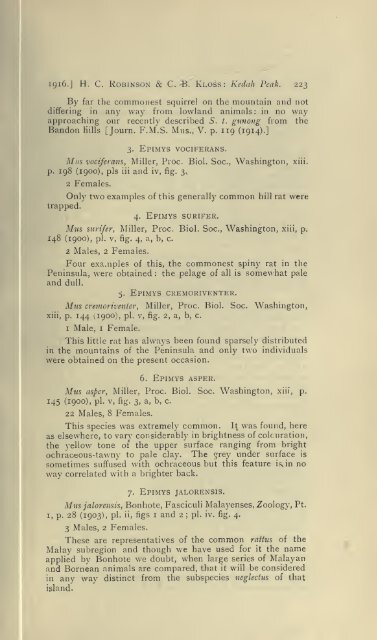Journal of the Federated Malay States museums - Sabrizain.org
Journal of the Federated Malay States museums - Sabrizain.org
Journal of the Federated Malay States museums - Sabrizain.org
You also want an ePaper? Increase the reach of your titles
YUMPU automatically turns print PDFs into web optimized ePapers that Google loves.
i9i5."J H. C. Robinson & C. B. Kloss : Kedah<br />
Peak. 223<br />
By far <strong>the</strong> commonest squirrel on <strong>the</strong> mountain and not<br />
differing in any way from lowland animals: in no way<br />
approaching our recently described S. /. gtmong from <strong>the</strong><br />
Bandon Kills [Journ. F.M.S. Mus., V. p. 119 (1914).]<br />
3. Epimys vociferans.<br />
Mus vociferans, Miller, Proc. Biol. Soc, Washington, xiii.<br />
p. 198 (1900), pis iii and iv, fig. 3,<br />
2 Females.<br />
Only two examples <strong>of</strong> this generally common hill rat were<br />
trapped.<br />
4. Epimys surifer.<br />
Mus surifer, Miller, Proc. Biol. Soc, Washington, xiii, p.<br />
148 (1900), pi. V, fig. 4, a, b, c.<br />
2 Males, 2 Females.<br />
Four exa.nples <strong>of</strong> this, <strong>the</strong> commonest spiny rat in <strong>the</strong><br />
Peninsula, were obtained : <strong>the</strong> pelage <strong>of</strong> all is somewhat pale<br />
and dull.<br />
5. Epimys cremoriventer.<br />
Mus creniorivenier, Miller, Proc. Biol. Soc. Washington,<br />
xiii, p. 144 (1900), pi. V, fig. 2, a, b, c.<br />
I Male, I Female.<br />
This little rat has always been found sparsely distributed<br />
in <strong>the</strong> mountains <strong>of</strong> <strong>the</strong> Peninsula and only two individuals<br />
were obtained on <strong>the</strong> present occasion.<br />
6. Epimys asper.<br />
Mus asper, Miller, Proc. Biol. Soc. Washington, xiii, p.<br />
145 (1900), pi. V, fig. 3, a, b, c.<br />
22 Males, 8 Females.<br />
This species was extremely common. It was found, here<br />
as elsewhere, to vary considerably in brightness <strong>of</strong> colcnration,<br />
<strong>the</strong> yellow tone <strong>of</strong> <strong>the</strong> upper surface ranging from bright<br />
ochraceous-tawny to pale clay. The grey under surface is<br />
sometimes suffused with ochraceous but this feature is, in no<br />
way correlated with a brighter back.<br />
7. Epimys jalorensis.<br />
Mus jalorensis, Bonhote, Fasciculi Malaj'enses, Zoology, Pt.<br />
I, p. 28 (1903), pi. ii, figs I and 2 ; pi. iv. fig. 4.<br />
3 Males, 2 Females.<br />
These are representatives <strong>of</strong> <strong>the</strong> common rattus <strong>of</strong> <strong>the</strong><br />
<strong>Malay</strong> subregion and though we have used for it <strong>the</strong> name<br />
applied by Bonhote we doubt, when large series <strong>of</strong> <strong>Malay</strong>an<br />
and Bornean animals are compared, that it will be considered<br />
in any way distinct from <strong>the</strong> subspecies neglectus <strong>of</strong> that<br />
island.

















